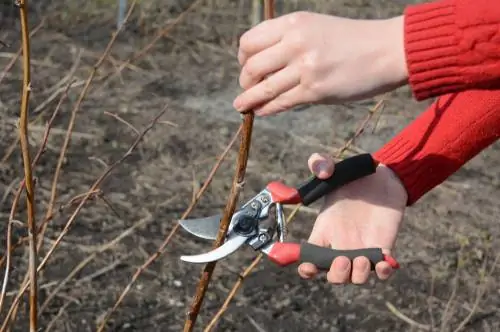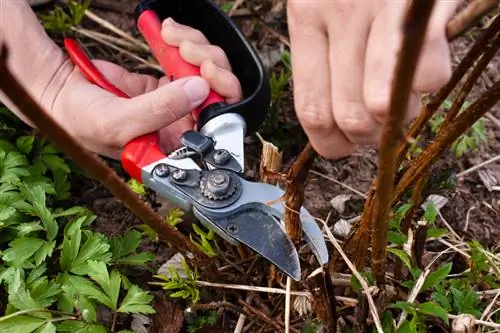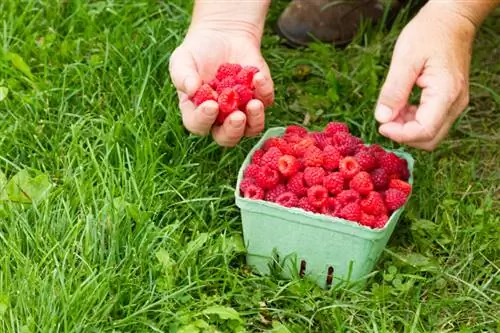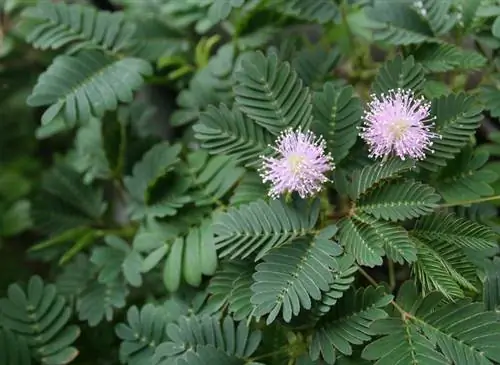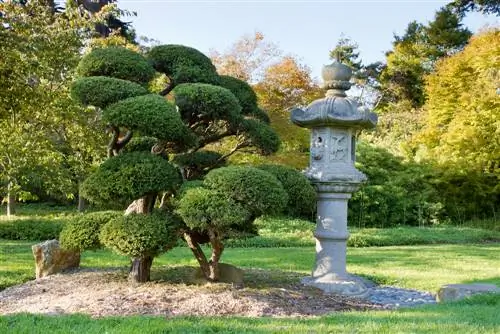- Author admin [email protected].
- Public 2023-12-24 06:09.
- Last modified 2025-06-01 06:02.
Properly trimmed raspberry bushes give private gardeners gifts of juicy, sweet fruit pralines. Without a cut, the popular berry bushes quickly turn into a dense tangle of shoots with meager harvest yields. In this tutorial you can read when and how to prune summer raspberries and autumn raspberries.
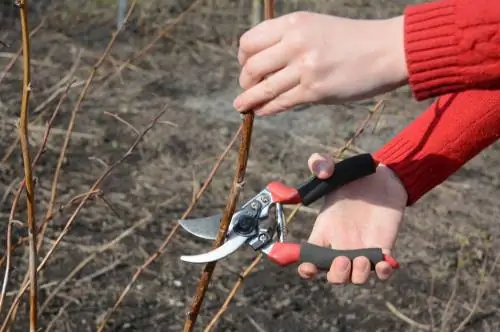
How far do you have to cut raspberries?
After harvesting, cut the raspberries so far that the plants only reach a few centimeters above the ground. When pruning, you only shorten the rods. Prune summer raspberries twice a year - in February or March and after harvest.
Distinguish between summer raspberries and autumn raspberries
There are a variety of raspberry varieties to choose from in tree nurseries and garden centers. Gardeners can choose between summer raspberries and autumn raspberries or take both varieties home with them. To help you make the right choice, the following overview summarizes the outstanding differences:
- Summer raspberries bloom and fruit on thelast year's shoots shoots
- Advantage: early harvest from June with larger fruits
- Autumn raspberries are blooming and fruitingthis year's shoots
- Advantage: easy training and pruning care
When it comes to growth, summer and autumn raspberries pull together. Premium varieties such as 'Aroma Queen', 'Blissy' or 'Sanibelle' boast rapid annual growth of up to 120 centimeters. Anyone who does not ensure order and control with regular pruning measures will have to contend with the invasive spread of long, prickly tendrils in the garden within a few years.
Cutting types and recommended dates
Bulging harvest baskets with tenderly melting raspberries are not least the result of skilfulpruningat theright time Make sure in advance whether Summer or fall raspberries are in your garden. This largely depends on when and how you cut the berry bushes correctly. The following overview lists all types of cuts with tips on the best time:
| Cut style | Goal/Occasion | best time |
|---|---|---|
| Planting and training summer raspberries | clear shrub structure | after planting |
| Planting and training autumn raspberries | light-flooded, controlled growth | after planting |
| Spring cut | Summer raspberries promote fruit wood, limit height growth | February to March |
| Summer cut | Thinning out summer raspberries | after harvest |
| Autumn cut | Keep autumn raspberries young and productive | after harvest or in February |
Summer raspberries - planting and training pruning
The successful cultivation of summer raspberries is based on experttraining on a trellisA frame made of wooden posts with clampedwires at 30 cm has proven to be excellent in the home garden, 100 cm and 180 cm heightThe length of the trellis depends on the number of young raspberries planted with an ideal planting distance of 50 centimeters. The best time to plant is in early autumn, when rooting progresses quickly in the sun-warmed soil. This is how to plant and train summer raspberries successfully:
- After planting or in February, cut back all shoots to 30 centimeters, or 4 eyes
- Cover with a layer of autumn leaves, secured with pine branches or compost
- Remove winter protection in early to mid-March
- In May, tie the5 to 10 strongest canes per running meter well distributed on the trellis
- Cut off all remaining tendrils at ground level
As the season progresses, tie the selected canes vertically to the wire trellis in accordance with their growth. Please useflexible binding material that does not cut into the soft bark. Since summer raspberries grow up to 120 centimeters a year, individual shoots sometimes protrude over the trellis in autumn. Between November and February, trim the cane tips to a hand's width above the top trellis wire.
Excursus
Rose gloves protected against annoying thorns
Raspberries cannot deny that they belong to the rose family. The most popular varieties are covered in sharp spines. So that the scratchy tendrils don't spoil your enjoyment of pruning, impenetrable rose gloves ensure pain-free work. Made of leather or puncture-resistant nitrile and with extra long cuffs, with the special gloves you are well prepared for cutting all thorny berry bushes, such as raspberries, gooseberries or blackberries.
Autumn raspberries - planting and training pruning
Autumn raspberries make pruning care easy for you. Since the berry bushes are cultivated as an annual, there is no need for time-consuming tying and training on a wire trellis. You give the flexible tendrils reliable stability by hanging a structural steel mesh or similar grid horizontally between two wooden posts at a height of 80 to 100 centimeters. The rods can grow through this and don't tip over under their sweet weight. This is how you plant and train autumn raspberries correctly:
- After planting or in February, cut all shoots back to 30 centimeters or 4 buds
- Cover the planting site with leaves and fix it with a thin layer of compost
- Remove winter protection in good time before budding begins
- In May per running meter15 to 20 strong rods select
- Cut off all remaining shoots just above the ground and pull them out of the bush
The annual cultivation of autumn raspberries easily allows twice the number of fruit canes per linear meter of cultivation area compared to summer raspberries. There shouldn't be more than 20 canes because too dense growth promotes fungal infections, such as the dreaded cane disease.
Background
Cutting raspberries with bypass or anvil scissors?
The botanical classification of raspberries as a rose family is not only expressed in the growth of thorny shoots. Solid wood also indicates a close relationship to rose bushes. This requires sharp pruning shears for the cut, which leaves smooth cuts. Specialist retailers offer bypass and anvil shears for this purpose. Bypass shears work with two sharp cutting edges that cut up a shoot without fraying the edges of the wound. However, the bypass mechanism requires more effort. In contrast, anvil shears cut more effortlessly, but there is a risk of bruising shoots. The reason is that it works with a sharp cutting edge that presses the branch against a blunt anvil and only then cuts it. Since each mode of operation has individual advantages and disadvantages, the decision is subject to your horticultural assessment.
Cut summer raspberries twice a year
Starting in the second year, summer raspberries thrive on the trellis with two generations of rods. Side by side stand last year's fruiting vines and this year's canes for next year's raspberry harvest. This can cause confusion even among experts. So that you don't accidentally cut off valuable young canes and leave old canes standing, cut your summer raspberries after the harvest. How to do it right:
- After harvesting, cut off all empty vines to a hand's width above the ground
- In exchange, select the 10 best rods and tie them to the trellis
- Cut off excess ground shoots and pull them out of the berry bush
As the illustration below illustrates, following summer pruning, young raspberry canes have enough light, air and space for vital growth. The tendrils will be spared any pruning measures until next spring. Only in February or March do shoots that are too long cut back to an advantageous height of 150 to 180 centimeters. Take this opportunity to thin out dead or frozen wood at ground level.
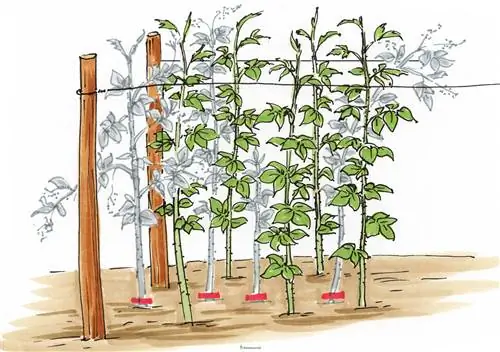
Summer raspberries thrive on the head-high wire trellis. After harvesting, cut off any worn canes. Tie up the ten strongest vines this year. In February, cut the shoot tips to a harvest-friendly height of 150 to 180 centimeters.
Cut autumn raspberries once a year
Autumn raspberries grow, bloom and fruit in the same year. Like all fruit trees that bear their fruit on this year's wood, pruning care is easy. The year after planting, select 15 to 20 of the best vines for that year's harvest. An uncomplicated rhythm for annual pruning then sets in. How to do it right:
- Cutting autumn raspberries after harvest
- Cut all rods to a hand's width above the ground
- Cover the bed with leaves and coniferous twigs or pile it up with compost
Remove the protective foliage in the spring in good time before budding. Young tendrils begin to grow rapidly, allowing them to grow through the recommended wire trellis. If more than 20 canes are growing per meter, select the most vital shoots in May and thin out any excess. Please measure the cutting circumference according to the rule of thumb: the fewer fruit canes, the larger and juicier the raspberries.
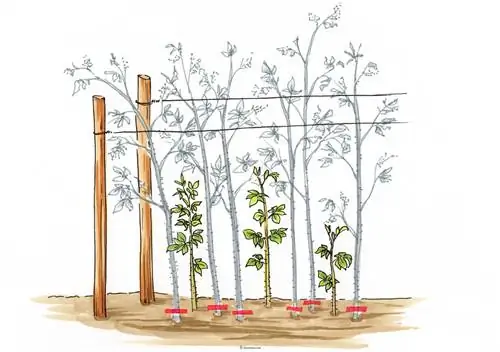
In autumn or early spring, cut off all canes at the base. Autumn raspberries thank you for the radical pruning with strong shoots and large, juicy fruits.
Background
Sleeping eyes guarantee fresh growth after winter
After the autumn pruning, there is hardly any autumn raspberries to be seen. How can it be that next year massive, densely leafed tendrils with delicious raspberries will appear in this spot again? The solution to the puzzle lies hidden insleeping eyes, which are almost invisible under the bark and in the rhizome. Specifically, these are buds in a dormant state. Cutting the above-ground shoots causes dormant buds to be activated. Just in time for the beginning of the growth phase in spring, raspberries emerge from their sleeping eyes that have come to life.
Special case of two-timer raspberries
There is no new type of raspberry hidden behind the variety name 'Two-Timer Raspberries'. Rather, these are autumn raspberries that are blended like summer raspberries. In fact, any fall raspberry can bear fruit on both this year's and last year's canes. Breeders take advantage of this property and offer hobby gardeners two-timer raspberries, such as the well-known 'Sugana', as a special variety innovation. There is no pruning after the harvest so that the fruit canes produce raspberries a second time in early summer of the following year. This results in this cut care:
- After planting: cut back to 30 cm or 4 buds
- In May of the following year: select 10 to 15 of the best rods per meter, remove all others
- First harvest time in June on last year's canes, second harvest time in August on this year's canes
- Each year in February/March, cut off all two-year-old canes, leaving the previous ones for a harvest in June
Commercial fruit cultivation ignores two-timer raspberries. The primary reason is the complex cultivation, coupled with a longer harvest time and a lower yield per plant. Since productivity and work efficiency are secondary in the snack garden, the new raspberries become the focus with the twice-harvesting on each fruit cane.
Cutting raspberries on a stick
In small gardens, for cultivation in a bucket on the balcony, raspberries can be trained on a stick. Instead of assembling a wire trellis or hanging a trellis, use a wooden post about 2 meters high as a support. Plant your favorite raspberry variety in nutrient-rich, well-drained soil in close proximity to the stick. A plant cut of 30 centimeters promotes vital branching. Tie the 5 strongest rods to the rod with soft tube ties. Cut off excess ground shoots at the base.
After harvesting, cut autumn raspberries back to short stumps and loosen the canes from the stake. On summer raspberries, thin out canes that have been removed after the harvest to make room for this year's shoots. You gradually guide these up the rod. As the illustration below shows, there should be no more than five rods on the pole.
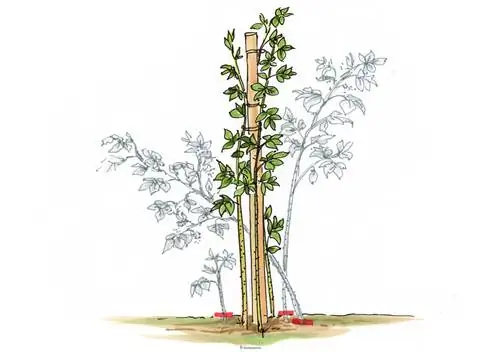
When there is a lack of space, raspberries thrive on poles. More than five fruit canes should not be gathered on the stick. Therefore, cut off excess ground shoots consistently.
Frequently asked questions
Are raspberries self-fertile?
In fact, raspberries thrive as specimen plants and give you a rich harvest. A supplementary pollinator variety is not required. If space allows, we still recommend planting two raspberry bushes to optimize yield. In addition, you can effectively prevent crumb fruiting if you grow two types of raspberries. Pure self-fertilization is always accompanied by the risk that the raspberries will simply fall apart when picked.
According to the instructions, I cut the autumn raspberry 'Aroma Queen' back to the ground in spring. Two weeks have now passed and there is still no growth to be seen. What to do?
The time of pruning and sprouting are not directly related. As an autumn raspberry, 'Aroma Queen' takes until mid/late May to begin this year's growth. Supplementary nutrient supply and regular watering are helpful. Apply mature compost with horn shavings or an organic berry fertilizer. If no shoots can be seen from the ground by the end of May, the raspberry has probably died.
My summer raspberry is in full sun and bore a lot of fruit in its first summer. Since mid-August the leaves have turned yellow and not a single new shoot has grown. Should I fertilize and prune the berry bush before autumn?
As a result of cool, wet weather, your summer raspberries will probably go into dormancy earlier. The plant shifts the remaining nutrients from the leaves into the roots, so that the foliage turns yellow. Raspberries are no longer fertilized from the beginning of August, otherwise the berry bushes will not ripen before winter and could freeze to death. Only in spring do you apply organic fertilizer again. On summer raspberries, the older, worn shoots dry back in winter and are cut down to the ground in February.
Are raspberries suitable for keeping in a pot with a trellis?
Container storage is possible for all raspberry varieties as long as an adequate supply of water and nutrients is ensured. An integrated trellis provides sufficient support for the long shoots. It is important to note that you repot the raspberries more often so that new shoots develop in the substrate. If a rhizome becomes too large, you can divide it in autumn or spring without hesitation.
Is it possible to plant young raspberries in a place where there were already raspberry bushes?
Unfortunately this is not possible. Raspberries belong to the rose family, whose growth is accompanied by soil fatigue. This is a natural process that prohibits a seamless succession of rose plants or at least entails significant disadvantages. If one raspberry bush follows the next, you will have to deal with sick, weak and stunted plants. You can either plant plants from a different family at the location for three to five years or replace the soil over a large area.
Are there raspberries without thorns?
A colorful array of thornless raspberry varieties makes cultivation even easier and, above all, less painful. The innovative variety Primeberry Autumn Amber thrives as an uncomplicated autumn raspberry with yellow fruits and has no sting. If you prefer to harvest red raspberries from thornless vines, choose Primeberry Mailing Happy. The dwarf variety Lowberry Red Princess, which has also made a name for itself as a thornless premium variety, is ideal for small gardens.
Our two-timer raspberries only branch a little. Can I promote branching by cutting?
Raspberries don't naturally branch very well. Rather, the berry bushes form very long, annual canes. Only in the second year do the annual canes branch out. These side branches then bear fruit. The Two-Timer Raspberry combines this growth with a slim, upright silhouette. You cannot reinforce natural branching with one cut. The two-timer variety 'Sugana' gets quite bushy anyway because it produces both annual and biennial wood.
The 3 most common cutting mistakes
If a raspberry bush presents itself as a hopeless tangled mess of many old and a few young shoots with stunted fruits, there are usually typical mistakes in pruning care behind it. To protect you from unpleasant problems when growing raspberries, the following table draws attention to the three most common pruning mistakes:
| Cutting errors | malicious image | Prevention |
|---|---|---|
| never cut | impenetrable thicket of rotten vines | Cut raspberries at least once a year |
| Summer raspberries cut like autumn raspberries | Failure of the next harvest | On summer raspberries after harvesting, only cut off the empty canes |
| Autumn raspberries cut in summer | Total failure of this year's harvest | Cut autumn raspberries completely level with the ground after harvesting |

Tip
Raspberries tend to have pronounced growth with runners. Planting with a root barrier is an effective way to prevent the berry bushes from taking over the entire garden. Line the planting pit about 30 centimeters deep with pond liner or a special rhizome barrier.

